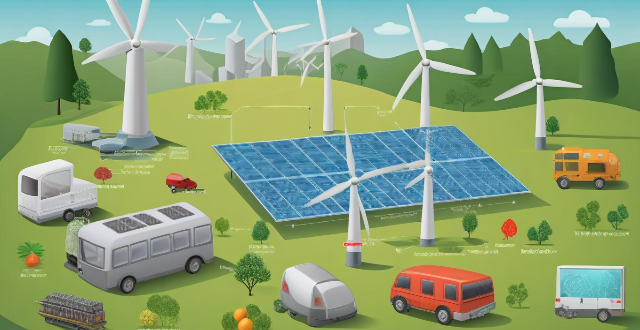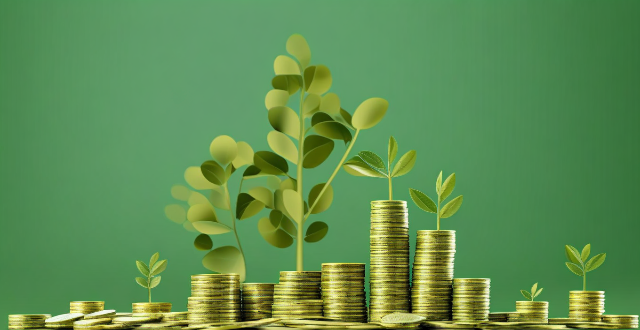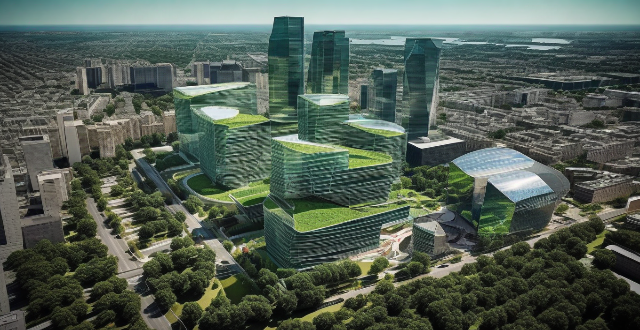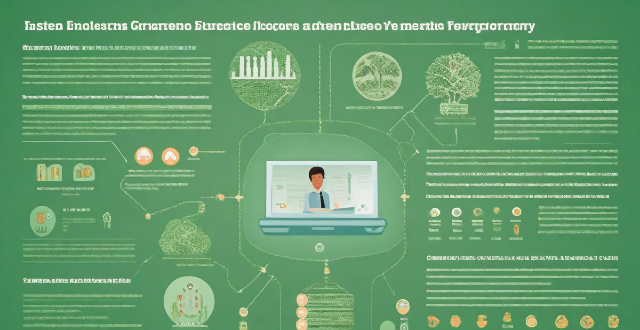Green Carbon

How can green technology reduce carbon emissions ?
In this article, we explore how green technology can help in reducing carbon emissions. We discuss renewable energy sources such as solar, wind, hydro, geothermal, and biomass energy, which produce little to no greenhouse gas emissions during operation. We also emphasize the importance of improving energy efficiency and conservation, utilizing carbon capture and storage technologies, and promoting electric vehicles. By implementing these green technologies, we can significantly reduce our carbon footprint and create a more sustainable future for generations to come.

What is green finance ?
Green finance is the use of financial instruments and strategies to support environmentally friendly projects. It includes sustainable investing, green bonds, green banks, carbon credits, impact investing, climate-related disclosures, ESG criteria, green indexes, green funds, green insurance, green tax incentives, green microfinance, green real estate, green technology, and green partnerships. The goal of green finance is to promote economic growth while minimizing negative impacts on the environment.

What role do banks play in promoting green finance ?
Banks promote green finance by offering loans for sustainable projects, investing in eco-friendly companies, and introducing green products. They also educate customers on sustainability and collaborate with governments and NGOs to support green initiatives.

How does green finance contribute to sustainable development ?
Green finance plays a pivotal role in driving sustainable development by channeling financial resources towards environmentally friendly projects and initiatives. Here's a detailed look at how it contributes: 1. Promoting Renewable Energy 2. Supporting Green Infrastructure 3. Advancing Clean Technology 4. Influencing Corporate Behavior 5. Regulating Financial Markets 6. Educating Investors and the Public

How can we promote the use of green technology ?
Green technology is essential for mitigating climate change and ensuring a sustainable future. To promote its use, strategies include education campaigns, integrating sustainability into school curricula, offering financial incentives and tax breaks, implementing regulations, funding research and development, encouraging corporate responsibility, supporting community projects, showcasing successes, participating in global agreements, promoting eco-labeling, and encouraging green marketing. These efforts can drive innovation, create jobs, and foster economic development sustainably.

Can green bonds help fight climate change effectively ?
Green bonds, a type of fixed-income instrument, are issued to fund environmentally friendly projects that aim to reduce greenhouse gas emissions and promote sustainable development. They can effectively contribute to the fight against climate change by incentivizing renewable energy projects, supporting energy efficiency and conservation, investing in low-carbon infrastructure, promoting sustainable agriculture and forestry, and advancing research and development. However, challenges such as ensuring transparency and accountability, achieving scale and impact, integrating with broader climate strategies, and engaging diverse investors must be addressed to fully realize their potential. As the market for green bonds grows, they remain an important tool in combating climate change effectively.

What role do urban green spaces play in climate adaptation strategies ?
Urban green spaces play a crucial role in climate adaptation strategies by providing cooling effects, carbon sequestration, flood control, and habitat preservation. To effectively incorporate these spaces into climate adaptation efforts, city planners should conduct assessments, develop comprehensive plans, collaborate with local communities, monitor and evaluate projects, and educate residents about the benefits of green spaces.

What is the future outlook for green jobs ?
The future outlook for green jobs is promising, asThe future outlook for green jobs is promising, as eco-friendly practices continues to The key factors driving this growth include government policies, consumer demand, technological advancements, corporate social responsibility, and international collaboration. Examples of green jobs include renewable energy technicians, sustainability managers, green building designers, waste management professionals, conservation scientists, and environmental lawyers.

What are the benefits of using green packaging ?
Using green packaging has become increasingly popular in recent years as people have become more aware of the environmental impact of traditional packaging materials. Green packaging refers to eco-friendly and sustainable packaging solutions that are designed to reduce waste, conserve resources, and minimize pollution. Here are some of the benefits of using green packaging: Reduced Environmental Impact: - Lower Carbon Footprint: Green packaging materials often require less energy to produce than traditional materials, resulting in a lower carbon footprint. - Biodegradable and Recyclable: Many green packaging options are made from biodegradable or recyclable materials, reducing the amount of waste that ends up in landfills. - Reduced Pollution: Green packaging helps to reduce pollution by minimizing the use of harmful chemicals and toxins in the production process. Cost Savings: - Long-Term Cost Efficiency: While green packaging may initially be more expensive than traditional options, it can lead to long-term cost savings due to reduced waste disposal costs and increased efficiency in production processes. - Tax Incentives and Grants: Many governments offer tax incentives and grants for businesses that implement eco-friendly practices, including the use of green packaging. Improved Brand Image: - Enhanced Corporate Social Responsibility (CSR): Using green packaging demonstrates a commitment to sustainability and social responsibility, which can enhance a company's reputation and appeal to environmentally conscious consumers. - Increased Customer Loyalty: Consumers who value eco-friendly practices are likely to choose products with green packaging over those with traditional packaging, leading to increased customer loyalty and sales. Innovation and Creativity: - Stimulates Innovation: The need for sustainable packaging solutions encourages companies to invest in research and development, leading to innovative new products and processes. - Design Flexibility: Green packaging materials can often be molded into unique shapes and sizes, allowing for greater creativity in product design. Health Benefits: - Reduced Exposure to Harmful Chemicals: Green packaging materials are often free from harmful chemicals and toxins, reducing the risk of exposure for both consumers and workers involved in the production process. - Improved Food Safety: Eco-friendly packaging materials can help maintain food quality and safety by preventing contamination and extending shelf life.

What is green finance and how does it relate to climate change ?
Green finance is the financing of projects that have environmentally friendly impacts, such as reducing carbon emissions or conserving natural resources. It involves investing in renewable energy sources, clean technologies, and sustainable infrastructure projects that aim to mitigate climate change and promote a greener economy. The relationship between green finance and climate change includes impact on carbon emissions, promotion of sustainable practices, innovation and technology development, risk management and resilience, market incentives and policy support, stakeholder engagement, and international cooperation. Green finance plays a crucial role in addressing climate change by directing capital towards environmentally beneficial projects and practices.

What are the benefits of carbon sequestration in reducing global warming ?
Carbon sequestration helps to reduce greenhouse gas emissions and stabilize climate conditions, leading to improved air quality and public health. It also promotes sustainable development by supporting renewable energy sources and creating green infrastructure. Additionally, carbon sequestration creates job opportunities and stimulates innovation in various industries. In the long term, it preserves biodiversity and prevents extreme weather events caused by climate change.

What are the benefits of green jobs ?
Green jobs, also known as sustainable jobs or eco-friendly employment, refer to positions that contribute positively to the environment and help in mitigating climate change. These jobs are often focused on renewable energy, energy efficiency, pollution control, waste management, and environmental conservation. The benefits of green jobs are multifaceted and can be categorized into economic, environmental, and social dimensions. In summary, green jobs offer a triple win by stimulating economic growth, protecting the environment, and enhancing social well-being. As societies continue to prioritize sustainability, the importance of these jobs will only increase, making them a cornerstone of future employment landscapes.

What are the benefits of investing in green finance ?
The text discusses the benefits of investing in green finance, which supports environmentally friendly projects. It highlights three main categories of benefits: environmental, economic, and social. Environmental benefits include reducing carbon emissions, conserving natural resources, and protecting biodiversity. Economic benefits encompass job creation, innovation stimulation, and reduced energy costs. Social benefits involve improving public health, promoting social equity, and enhancing the quality of life. The article emphasizes that investing in green finance contributes to sustainable development and a better future for all.

What role does government play in promoting green technology ?
The government plays a crucial role in promoting green technology. This is because the government has the power to create policies and regulations that can encourage the adoption of sustainable practices and technologies. Here are some ways in which the government can promote green technology: 1. Funding and Incentives 2. Regulations and Standards 3. Public Awareness Campaigns 4. Collaboration with Industry

How can companies integrate green finance into their business models ?
How Can Companies Integrate Green Finance into Their Business Models? Incorporating green finance is essential for sustainable growth and meeting ESG criteria. Here are some ways companies can integrate it: 1. Assessment of Environmental Impact: Conduct carbon footprint analysis and environmental risk assessment to identify areas for improvement. 2. Green Investments: Invest in renewable energy projects and develop energy-efficient infrastructure to reduce reliance on fossil fuels. 3. Green Products and Services: Develop sustainable products and eco-friendly services that minimize waste and promote sustainability. 4. Financing and Funding: Issue green bonds and seek financing from banks offering loans specifically for sustainable projects. 5. Reporting and Transparency: Regularly report on environmental performance, encourage independent audits, and build trust with investors. 6. Collaboration and Partnerships: Work with suppliers to implement sustainable practices and partner with organizations committed to sustainability. 7. Incentives and Benefits: Take advantage of government incentives, seek out grants, and obtain certifications to enhance green credentials. 8. Employee Engagement and Training: Create green teams and offer training programs to educate employees about sustainability. By adopting these strategies, companies can enhance their competitiveness and attract investors and consumers who prioritize sustainability.

How can urban green spaces improve residents' quality of life ?
Urban green spaces, including parks and community gardens, play a key role in enhancing the quality of life for city residents by providing physical, mental, social, and environmental benefits. Physical health is improved through increased physical activity, better air quality, and mitigation of the heat island effect. Mental health benefits include stress reduction, enhanced mood, and improved cognitive function. Social well-being is boosted through community building, recreational opportunities, and educational value. Environmentally, urban green spaces contribute to biodiversity conservation, water management, and carbon sequestration. These areas are essential for comprehensive wellness in urban environments and should be a focus in future city planning.

How can individuals participate in carbon offsetting ?
Carbon offsetting allows individuals to compensate for their carbon emissions by investing in projects that reduce atmospheric CO2. To participate, understand your carbon footprint, choose a reputable offset provider, and set an offset goal. Support green energy, plant trees, adopt sustainable practices, and educate others on the importance of offsetting. This helps mitigate personal emissions and supports sustainability initiatives.

How can green finance contribute to achieving the goals of the Paris Agreement on Climate Change ?
Green finance can contribute significantly to achieving the goals of the Paris Agreement on Climate Change by directing capital towards environmentally friendly projects and companies. It involves green bonds, loans, investment funds, and sustainable insurance products that support renewable energy development, low-carbon infrastructure, sustainable agriculture, forestry, mitigation, and adaptation to climate change. However, challenges such as risk management, return on investment, and lack of consistent data and standards need to be addressed to fully realize its potential.

How does green technology help the environment ?
Green technology, or clean technology, includes various techniques and products designed to reduce environmental harm. Its benefits include reducing greenhouse gas emissions, conserving natural resources, protecting ecosystems, reducing waste, and promoting sustainable practices. These technologies help minimize pollution, save energy, preserve water, maintain biodiversity, and encourage recycling and responsible waste management. As green technology advances, its positive impact on the environment is expected to increase.

What is the significance of using green technologies in buildings for energy conservation ?
Green technologies play a crucial role in promoting energy conservation within buildings. They aim to reduce the negative impact of human activities on the environment and promote sustainable development. The significance of using green technologies in buildings for energy conservation includes improving energy efficiency, reducing carbon emissions, promoting renewable energy use, enhancing natural resource management, improving indoor air quality and noise reduction, reducing operating costs, and increasing property value. As we strive towards a more sustainable future, adopting these technologies becomes increasingly important.

How effective is a carbon tax in reducing greenhouse gas emissions ?
A carbon tax is a fee on burning carbon-based fuels aimed at reducing greenhouse gas emissions. It creates economic incentives for behavior change, technology innovation, and revenue generation. The effectiveness depends on rate setting, equity concerns, compliance, political feasibility, and international coordination.

What are the economic benefits associated with urban green spaces ?
Urban green spaces provide economic benefits to cities, including increased property values, reduced air pollution, and enhanced tourism. These spaces improve the living environment, leading to higher home and rental prices, increased tax revenue, and healthcare cost savings. Additionally, they attract tourists, boosting the local economy through job creation and multiplier effects. Investing in urban green spaces is beneficial for both the environment and city prosperity.

What is green building and why is it important for the construction industry ?
Green building is an approach to design, construction, operation, and maintenance of buildings that aims to minimize environmental impact and resource consumption throughout a building's lifecycle. It focuses on sustainability, energy efficiency, water conservation, materials selection, and indoor environmental quality. The importance of green building in the construction industry stems from environmental concerns, economic benefits, and social responsibility. Green buildings reduce carbon footprint, conserve resources, preserve biodiversity, save energy costs, have higher asset values, and promote healthier living conditions. They also set community standards for sustainable practices and help companies stay ahead of compliance requirements. Green building drives innovation in materials science, design techniques, and construction technology. Overall, green building represents a fundamental shift towards more sustainable and responsible practices within the construction industry.

How can green finance help reduce carbon emissions and combat climate change ?
Green finance employs financial resources to support environmental sustainability, aiming to reduce carbon emissions and combat climate change. Strategies include prioritizing renewable energy investments, supporting clean transportation, encouraging sustainable agriculture, promoting energy efficiency in buildings, increasing investment in climate change adaptation, creating markets for carbon credits, and enhancing environmental risk management. These actions help redirect capital towards eco-friendly activities, offering new business opportunities and attractive returns for investors focused on sustainability.

How can a carbon tax be designed to minimize negative impacts on businesses ?
A carbon tax is a fee on burning carbon-based fuels to reduce emissions and promote clean energy. To minimize its negative impact on businesses, consider gradual implementation, incentives for innovation, clear policy, revenue neutrality, support for affected industries, collaboration, and monitoring. This balances environmental goals with economic realities for sustainable development.

How can we encourage more people to adopt green technology ?
In this article, the author discusses various ways to encourage people to adopt green technology. These include education and awareness, financial incentives, government policies and regulations, collaboration and partnerships, and research and development. The author emphasizes the importance of promoting the benefits of green technology, highlighting its environmental impact, and sharing success stories. They also suggest offering tax credits, rebates, grants, and low-interest loan programs to incentivize individuals and businesses to invest in green technology. Additionally, the author recommends implementing mandatory standards for energy efficiency and emissions reduction, creating incentive programs for companies that exceed environmental regulations, and prioritizing the purchase of green technology products by government agencies. Collaboration with industry leaders, non-profit organizations, and local communities is also crucial in promoting the adoption of green technology. Finally, the author suggests investing in innovation, supporting startups working on green technology solutions, and facilitating access to resources for researchers and developers.

What is the significance of green infrastructure in managing urban runoff and improving water quality ?
Green infrastructure (GI) is a sustainable approach that uses natural processes to manage stormwater, reduce pollution, and enhance the overall health of urban ecosystems. It plays a crucial role in managing urban runoff and improving water quality. Some benefits of GI include reducing stormwater runoff, improving water quality, enhancing habitat and biodiversity, and mitigating climate change impacts. To effectively implement green infrastructure in urban areas, factors such as site selection, design considerations, and maintenance and management should be considered. Proper maintenance and management are essential for ensuring the long-term success of green infrastructure projects. By implementing effective green infrastructure practices, cities can create healthier, more resilient environments for both people and wildlife.

What is the concept of "green investing" and how does it relate to climate change ?
Green investing is a concept that involves directing financial resources towards companies, projects, or funds that prioritize environmental sustainability and social responsibility. It is an approach to investing that takes into account the environmental impact of investments, with the goal of promoting sustainable development and reducing the negative effects of climate change. The concept of green investing is closely related to climate change as it aims to address the environmental challenges caused by human activities. By investing in companies and projects that prioritize sustainability, green investors can help reduce carbon emissions, conserve natural resources, and promote renewable energy sources. This, in turn, can contribute to mitigating the effects of climate change and creating a more sustainable future.

What criteria should be met for a bond to be classified as a green bond ?
Green bonds are fixed-income instruments specifically designed to raise capital for climate and environmental projects. To be classified as a green bond, the issuer must meet certain criteria, including how the funds will be used, which projects are eligible, transparency in reporting, certification and review by third parties, and additional requirements depending on the framework being used. These criteria ensure that the funds raised through issuance of the bond are used for environmentally sustainable purposes. Green bonds play a crucial role in financing sustainable development and promoting a low-carbon economy.

Does a carbon tax lead to "carbon leakage" where companies move to areas without the tax ?
The article discusses the potential for "carbon leakage," where companies might relocate to regions without a carbon tax to avoid additional costs. It highlights economic impacts, geographical considerations, industry-specific impacts, and mitigating factors that could affect the outcome of implementing a carbon tax. The potential negative outcomes include job losses and environmental displacement, while positive outcomes could be innovation and efficiency improvements. The conclusion emphasizes the need for coordinated international efforts and support for affected industries to minimize leakage and promote sustainable practices.